Intel Unveils Moorestown and the Atom Z600, The Fastest Smartphone Platform?
by Anand Lal Shimpi on May 4, 2010 11:54 PM EST- Posted in
- Smartphones
- Intel
- Atom
- Mobile
- SoCs
Moorestown: The Two Chip Solution That Uses Five Chips
Intel calls Moorestown a two-chip solution. That’s the Lincroft SoC and the Langwell IO Hub. Intel says there’s no architecture limitation for splitting these two up, it was just a way of minimizing risk. You put the bulk of the 3rd party technologies in the Langwell IO Hub and keep the important, mostly Intel controlled components in Lincroft. This is still the first SoC that Intel is going to market with, so splitting the design into two chips makes sense. The followon to Moorestown, codenamed Medfield, will integrate these two once Intel is comfortable.

The 45nm, 140M transistor Lincroft die
Lincroft houses the CPU, GPU and memory controller and is built on Intel’s 45nm process. This isn’t the same 45nm process used in other Intel CPUs, instead it’s a special low power version that trades 6 - 8% performance for a 60% reduction in leakage. The tradeoff makes sense since the bulk of these chips will run at or below 1.5GHz. And by the way, it’s now called the Atom Z600 series.
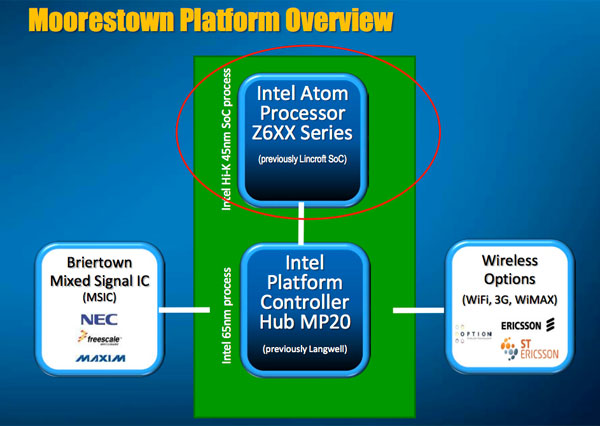
| Transistor Comparison | |||||
| Intel Atom Z5xx Series | Intel Atom Z6xx Series | NVIDIA Tegra 2 | |||
| Manufacturing Process | 45nm | 45nm | 40nm | ||
| Transistor Count | 47M | 140M | 260M* | ||
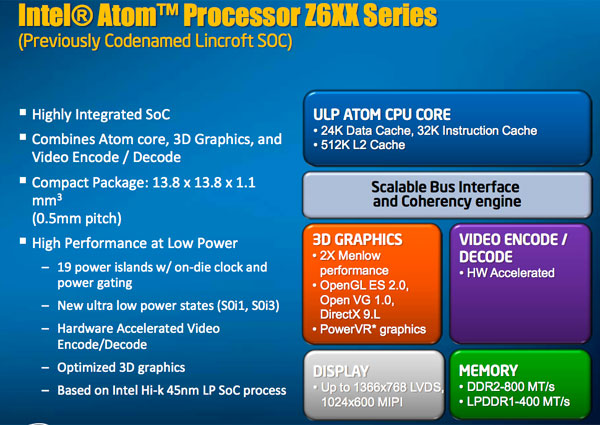
Langwell, now known as the Intel Platform Controller Hub (PCH) MP20, holds virtually everything else. It’s got an image processing core that supports two cameras (1 x 5MP and 1 x VGA), USB 2.0 controller, HDMI output (1080p) and a NAND controller that can support speeds of up to 80MB/s. The whole chip is managed by a 32-bit RISC core.
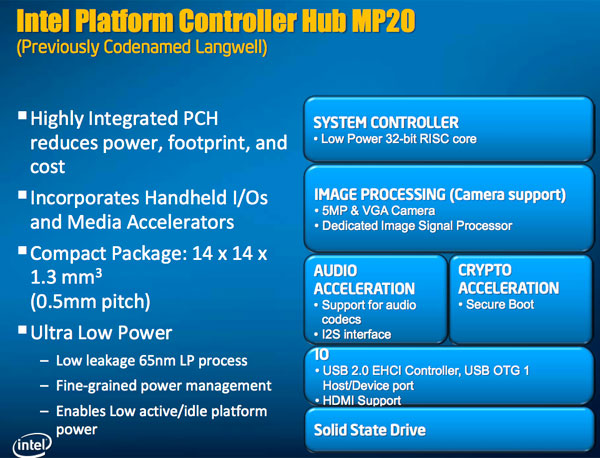
Langwell is a 65nm chip built at TSMC. TSMC has existing relationships with all of the IP providers for the blocks inside Langwell, so making it at TSMC is a sensible move (a temporary one though, with Medfield Intel will integrate all of this).
and_PlatformControllerHub_package2_sm.jpg)
Langwell (left) and Lincroft (right)
While Lincr, err, Atom Z600 and the Intel PCH MP20 are enough for a traditional system, they are not enough for a smartphone. You need wireless radios, that’s one chip for WiFi and one for 3G support. You need something to handle things like power management, charging the battery and controlling the touch screen. That’s an additional chip, called Briertown.
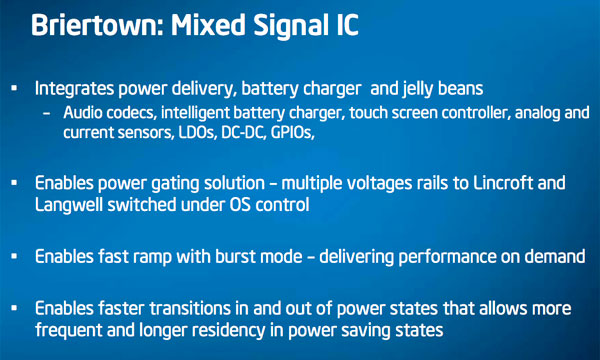
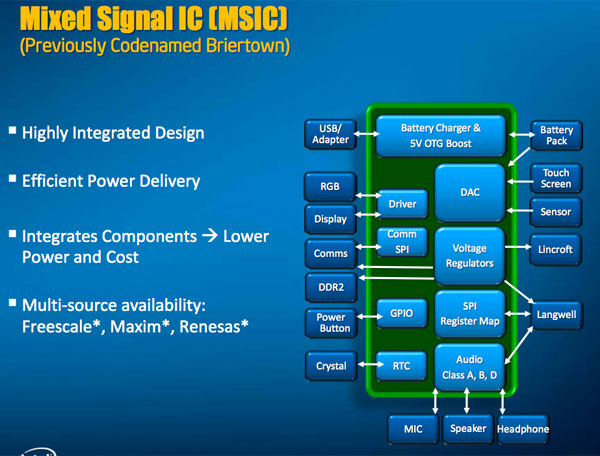
We’re up to four chips at this point, but you need at least one more. While modern day smartphone SoCs ship with on-package memory, Intel doesn’t yet support that. Obviously it’s not impossible to do, Marvell, TI, Qualcomm and Samsung do it with all of their SoCs. Look inside Apple’s iPad and you won’t see any DRAM chips, just a Samsung part number on the application processor package. Intel doesn’t have the same experience in building SoCs and definitely not in integrating memory so it’s not a surprise we don’t have that with Moorestown. Unfortunately this means a smartphone manufacturer will need as many as five discrete chips to support Moorestown.
| Platform Size | |||||
| Moorestown | |||||
| CPU + Chipset | 387 mm2 | ||||
| Total Platform Area | 4200 mm^2 | ||||
| SoC Package Size | 13.8 mm x 13.8 mm x 1.0 mm | ||||
| PCH Package Size | 14 mm x 14 mm x 1.33 mm | ||||
And now we know why Intel has been showing off its extremely long form factor prototype all this time:
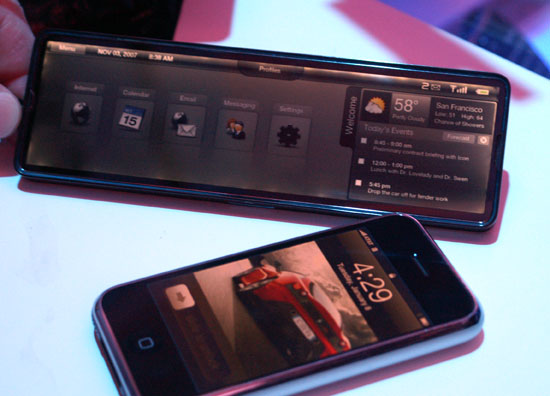










67 Comments
View All Comments
Mike1111 - Wednesday, May 5, 2010 - link
IMHO Anand meant app-centric smartphones, David Pogue calls them app phones.jasperjones - Wednesday, May 5, 2010 - link
i don't see how recent symbian devices are not "app centric." you have the publicly available sdk, the ovi store, etc.BrooksT - Wednesday, May 5, 2010 - link
So your argument is that symbian is a bigger player in the app phone market than Apple because their *latest* phones support apps?The "smartphone" / "app phone" semantic difference is annoying, but if we look at, say, number of applications available or downloaded, Symbian and RIM are distant third and fourth places. Likewise with app usage, even just internet browsing.
If you want to talk about smartphones as they existed in 2006, then yes, both Symbian and RIM are much bigger than Apple or Android.
jasperjones - Wednesday, May 5, 2010 - link
To clarify: I said "recent" because the first Symbian smartphones came out almost 10 years ago--of course, those weren't app-centric.My original comment on Anand's article still stands. I'm talking about IDC's and Canalys' reports on 2010:Q1 smartphone sales which became available just days ago. Of course, most of the smartphones sold by Nokia and RIM in the first quarter allow for installation of apps such as Facebook, Ovi Maps, etc., etc.
WaltFrench - Sunday, May 9, 2010 - link
“…Apple and Google dominate the smartphone market. This is utter nonsense.”All you have to do is to look at the developer space. How many app developers are creating apps for the unreleased RIM OS 6? … for the Symbian OS^3, due out in “select” markets sometime in Q3?
If older apps work OK in these new OS incarnations, and if Blackberry and Nokia users are heavy app downloaders (or for some reason will become heavy users), then the current sales-share leaders are relevant, but still not dominant, in the future of app phones.
nafhan - Wednesday, May 5, 2010 - link
I'm curious about the PCI bus requirement for Windows 7 that would prevent it from running on Moorestown devices. Does it have something to do with storage, maybe? I'm having trouble finding specifics online as well. If someone could enlighten me, it would be appreciated.DanNeely - Wednesday, May 5, 2010 - link
This is almost certainly a factor of windows being a monolithic kernel and MS not having any way to say "this PC doesn't do PCI". This is something that MS will have to deal with in the medium term future anyway. PCI slots are going away from some high end mobos; it's only a matter of time before they disappear from mainstream boards and stop being used to attach misc controllers like PATA (slowly going away entirely) or FireWire (FW3200 will need PCIe bandwidth). At that point intel will want to take it out of their chipsets as a cost saving feature, and oems will not be happy if they have to install a PCIe to PCI bridge to maintain windows compatibility.Drizzt321 - Wednesday, May 5, 2010 - link
Maybe HP/Palm should get with Intel and optimize WebOS for this. Much of the WebOS stack is just Linux, Webkit, plus other F/OSS stuff like gstreamer and the like so I wouldn't be surprised if it isn't as big an effort as, say, Symbian or anything like that.This could be a big break for Intel and HP/Palm, since HP/Palm needs something big to help it move on to the next WebOS device, and the OS could certainly see some benefits to more CPU power. I've heard the overclocking patches raising the CPU to 800MHz can really help things.
sleepeeg3 - Wednesday, May 5, 2010 - link
Please stop designing faster phones.Phone A lasts 24 hours standby
Phone B lasts 6 hours standby
After 6 hours, Phone B's battery is dead. How much use do you get out of a phone with a dead battery? 0.
999GHz x 0 is still... 0!
This push toward faster phones, without even considering battery life, is nuts. Phones are impractical tools for just about everything, but calling, messaging and photographs. None of these are CPU intensive. Dependability is more important than how fast the dial screen opens.
Moorestown may include better power architecture, but it throws this away by jacking up the processor speed.
Lets get back to practicality and make phones functional again. This push toward cutesy 1000mAH/1GHz+ phones that die in a few hours is moronic.
Is it too much to ask for phones that last a week?
metafor - Thursday, May 6, 2010 - link
There are plenty of phones that last a week...They even cost significantly less than GHz smartphones and usually don't come with a 2-year contract.
But they don't have giant 4.2" AMOLED screens (which btw, is ~50% of the power consumption) either.